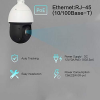Hello!
I have a new (to me) home that I'm interested in getting some security cameras set up around (surprising, I know). I want an always on system and be able to have alerts sent to my phone with the ability to tap into the live feed of any of my cameras any time. PoE seems like the best option to support that goal but I could use some feedback on things before I start ordering...
Currently, I've settled on a Blue Iris setup and have the following information mostly figured out, but some questions:
1. I'm going to buy a dedicated PC - seems like the i7-6700 in a dell optiplex with 256gb SDD + 4TB, 16-32GB, wifi + win10 pro would be a good option. Does windows need to be 64bit? Most eBay sellers don't seem to disclose the different OS varieties. Is there a recommended place to buy this particular component at a reasonable price?
2. 8 PoE cameras, maybe a combination of RLC-812A / RLC-842A but I really don't have a good feel for camera choices. Are there new versions of these cameras or other cameras I should consider?
3. Blue Iris
4. I assume I need some sort of powered ethernet switch to wire the cameras to and then back to the PC? No one ever seems to talk about this part on the youtube videos I've been watching. For 8 cameras, with the potential for a couple of more, what should I look to get that would support some future expansion?
5. Do I need anything else if I want to connect things into home assistant or some other automation in the future? e.g. turn X lights on when a human is detected type stuff.
Am I missing anything else I would need to buy to get everything working?
Thanks for any suggestions, I'm looking forward to getting things set up in the next few weeks.
I have a new (to me) home that I'm interested in getting some security cameras set up around (surprising, I know). I want an always on system and be able to have alerts sent to my phone with the ability to tap into the live feed of any of my cameras any time. PoE seems like the best option to support that goal but I could use some feedback on things before I start ordering...
Currently, I've settled on a Blue Iris setup and have the following information mostly figured out, but some questions:
1. I'm going to buy a dedicated PC - seems like the i7-6700 in a dell optiplex with 256gb SDD + 4TB, 16-32GB, wifi + win10 pro would be a good option. Does windows need to be 64bit? Most eBay sellers don't seem to disclose the different OS varieties. Is there a recommended place to buy this particular component at a reasonable price?
2. 8 PoE cameras, maybe a combination of RLC-812A / RLC-842A but I really don't have a good feel for camera choices. Are there new versions of these cameras or other cameras I should consider?
3. Blue Iris
4. I assume I need some sort of powered ethernet switch to wire the cameras to and then back to the PC? No one ever seems to talk about this part on the youtube videos I've been watching. For 8 cameras, with the potential for a couple of more, what should I look to get that would support some future expansion?
5. Do I need anything else if I want to connect things into home assistant or some other automation in the future? e.g. turn X lights on when a human is detected type stuff.
Am I missing anything else I would need to buy to get everything working?
Thanks for any suggestions, I'm looking forward to getting things set up in the next few weeks.






